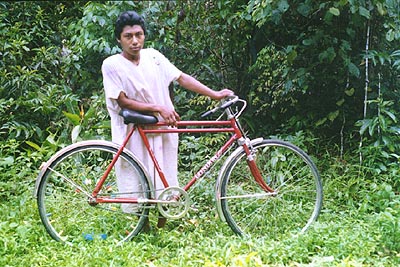
photo by R. Johnston

The modern Lacandon communities
By the 1970s, the Lacandons had resettled or been relocated by the government to three principle settlements: Lacanjá Chansayab, in the south and Najá and Metzabók (Mensäbäk) in the north of the Lacandon Rainforest. This consolidation into larger settlements began as the rainforest was opened for homesteading by the government in the 1940s (History Part 2). With the creation of the Zona Lacandona in 1971 most of the Lacandon families still living in remote areas were flown to one of the three large settlements. In the new towns, the evangelists found it easier to pursue the conversion of the Lacandons to Christianity. Roads first started to reach the communities in the late 1970's and now there is electricity in all three villages. With the new traffic and television outside influences have come flooding in. The ways in which the Lacandones have chosen to resist or adapt to change reflect their original sensibilities. Many Lacandons who had never seen an automobile in their youth, today repair their own trucks. In the event of illness, some may choose to placate the gods with ceremonies in the god house and then go to the clinic for western medicine.In many ways, the southern Lacandons living in Lacanjá Chansayab are culturally distinct from those of the north in Metzabók and Najá. Nevertheless, many northern families moved south to live in Lacanjá or settle the newer community of Bethel nearby. Proximity to a large area of pristine forest, more fertile land and conversion to Christianity (resisted in the north) are among the possible reasons for the north to south migration.
Lacanjá Chansayab (or simply Lacanjá), on the edge of the Monte Azules Biosphere Reserve near the ruins of Bonampak, is the main southern community. Living next to the largest intact area of the rainforest, game is still plentiful. The Lacandons are the only people permitted to hunt in the reserve. They know the seasonal habits of the animals that live in the jungle and have a considerable knowledge of edible and medicinal plants. Although many things about daily life in Lacanjá are uniquely Lacandon, their religion has not been practiced for may years. Tragically, important elders died in a yellow fever epidemic early in this century, disrupting the passing of tradition. The southern Lacandons, having become susceptible to missionaries and other outside influences, lost their traditional religious practices. Today the religion of the community of Lacanjá is protestant evangelist. The faithful attend a small chapel to sing Baptist hymns translated into Lacandon maya. A more recent major outside influence is the new highway that passes within 10 kms. of the community. The highway and construction underway to open Bonampak as a major tourism center will certainly have a great impact upon the community.
Geography: Lacanja Chansayab along the Lacanjá river is at 320 meters above sea level The Sierra Cojilita (at 620 mtrs.) to the east and the Monte Azules (at 1400 mtrs.) drain into the Rio Lacanjá and Laguna Lacanjá (at 250 mtrs.) 8 kms. south of the community.Metzabók (Mensäbäk), on a large lake surrounded by mountains, is the smallest Lacandon community. The lake provides good fishing and is the site of a number a sacred caves prehistoric rock paintings. The village being 4 kms away from the main road to El Tumbo has remote and tranquil atmosphere. At the same time this remoteness limits access to economic opportunities. Although the evangelists have had some influence here, much that is Lacandon survives. Nearby the village, Jose Camino Viejo and his wife still choose to live in isolation surrounded by their milpa and the remaining forest. They are possibly the last to live in this traditional setting. Jose Camino practices the original Lacandon sustainable agriculture, intercropping as many as 80 different kinds of food and fibre crops. Recent food shortages, due to cuts in subsidies as Mexico aligns itself with NAFTA (TLC), may make a return to this traditional Lacandon agriculture seem attractive.
Geography: Laguna Metzabok (at 550 mtrs.) lies at the foot of the Sierra Piedron to the north east. The community is five km. to the north of El Tumbo.Najá, by the lake of the same name, is the more traditional of the three communities. Attempts to evangelize the people here were largely unsuccessful. Polygamy, ceremonies in the god house, and the brewing of balche, beer of the gods, are some of the traditions surviving in Najá. Although encroaching deforestation is making traditional hunting and agriculture impracticable, cultural life survives in myth dream and cosmology. Najá was the home of Chan K'in Viejo whose charismatic personality helped sustain his people for three generations. At around 100, he was the oldest man in Najá and the one to be consulted regarding dream interpretation, myths or the rituals to supplicate the gods. Their is great pride in the community for the Lacandon culture. Their are children who remember their fathers stories vividly and can retell them at length with great animation.
Geography: Najá overlooks Laguna Najá (at 820 mtrs.) to the north which lies in a depression in the Monte Azules range 15 kms. north east of Monte Líbano.
![]()
This page hosted by Geocities Get your own Free Home Page